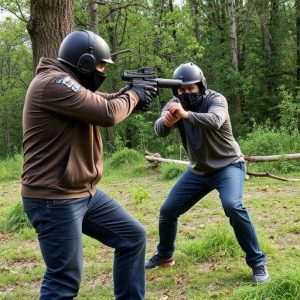Unveiling Stun Device Power: Electric Current Flow for Urban Safety
Stun guns, vital tools for personal safety in urban areas, utilize electric current to temporarily d…….
Stun guns, vital tools for personal safety in urban areas, utilize electric current to temporarily disable attackers through high-voltage, low-current pulses that disrupt neuromuscular signals. Operating at specific frequencies and with adjustable voltage settings, these devices create a strong electric field transmitted through metal prongs to disrupt muscular control. Key factors influencing effectiveness include voltage output, pulse duration, and electrode design. Safe use requires protective gear, proper training, and maintenance while considering shock level, weight, durability, tactical features, and reliability when choosing the best stun guns for urban safety.
Electrical current flow is the beating heart of stun devices, delivering powerful shocks designed to incapacitate assailants. Understanding how this process works is key to harnessing the potential of these self-defense tools. This article delves into the science behind stun devices, exploring the role of electrical current, its delivery mechanisms, and the factors influencing shock intensity. We’ll also uncover safety measures, providing insights on choosing the best stun guns for urban safety.
- Understanding Electrical Current: The Backbone of Stun Devices
- How Stun Guns Utilize Electric Current for Shock Delivery
- Key Components Involved in Current Flow within Stun Devices
- Factors Affecting the Intensity and Range of Electric Shocks
- Safety Measures and Precautions when Using Stun Devices
- Choosing the Best Stun Guns: A Comprehensive Guide for Urban Safety
Understanding Electrical Current: The Backbone of Stun Devices
Electrical current is the lifeblood of stun devices, enabling their effectiveness as tools for personal safety, especially in urban environments. Understanding how this flow of electrons functions is key to appreciating the capabilities and limitations of these devices. Stun guns, often considered the best option for urban safety due to their compact size and potent effects, operate by delivering a high-voltage, low-current electrical pulse to disrupt an assailant’s neuromuscular system.
This disruption causes intense pain, muscle spasms, and temporary paralysis, giving the user precious time to escape or seek help. The current flows through the device’s electrodes, which are strategically placed to make contact with the attacker’s body. This direct current (DC) pulse is designed to override the body’s natural electrical signals, ensuring the stun has a rapid and powerful effect.
How Stun Guns Utilize Electric Current for Shock Delivery
Stun guns, often considered essential tools for urban safety, leverage electric current to deliver powerful shocks that temporarily incapacitate targets. These devices use high-voltage, low-amperage electrical pulses to disrupt the target’s muscular control and motor functions. When activated, the stun gun generates a strong electric field, which is transmitted through metal prongs or probes in contact with the subject. The current flow disrupts nerve signals, causing intense muscle contractions and, subsequently, temporary paralysis. This effect enables users to subdue aggressive individuals without causing permanent harm, making best stun guns for urban safety highly effective tools for self-defense and law enforcement.
The electrical current in a stun gun operates at a specific frequency, typically ranging from 100 kHz to 4 MHz, which is above the audible range, ensuring that the victim cannot anticipate the shock’s timing or intensity. This high-frequency pulse allows for rapid discharge of energy, ensuring quick and powerful shocks. Modern stun devices also incorporate smart features like adjustable voltage settings, allowing users to customize the level of force based on situations, making them versatile tools for various urban safety scenarios.
Key Components Involved in Current Flow within Stun Devices
The flow of electrical current within stun devices, particularly best stun guns for urban safety, is a complex process that involves several key components working in harmony to deliver an effective shock. At the heart of it all is the power source, usually one or more high-voltage batteries, which provide the necessary energy to generate and transmit the electric current. These batteries are connected to the stun trigger—a mechanism that controls the flow of electricity, allowing for a precise discharge when activated.
The current then traverses through intricate wiring and conductors, designed to efficiently transmit the electrical energy from the source to the output terminals. These conductors are strategically placed within the device, ensuring optimal current distribution. Upon activation, the stun trigger initiates a circuit, causing the current to surge through the conductors and into the contact points on the stun probe or bar, which makes direct contact with the target. This rapid and intense current flow disrupts muscular control, immobilizing the subject, thereby enhancing urban safety for citizens carrying these devices as a means of self-defense.
Factors Affecting the Intensity and Range of Electric Shocks
The intensity and range of electric shocks delivered by stun devices are influenced by several key factors, crucial for those seeking effective urban safety solutions. One primary determinant is the voltage output. Higher voltage means stronger jolts, ensuring the best stun guns for urban settings deliver powerful enough shocks to incapacitate an assailant quickly. However, it’s essential to balance this with safety considerations and legal limits to avoid excessive harm.
Another factor is the current flow duration. A longer pulse width allows for deeper muscle contractions, increasing the effectiveness of the shock. This is particularly relevant in close-quarters urban encounters where a swift but powerful stun can be more beneficial than prolonged, less intense jolts. Additionally, the design and quality of the device’s electrodes play a role; well-designed electrodes ensure optimal current distribution, enhancing both intensity and range.
Safety Measures and Precautions when Using Stun Devices
When using stun devices, especially best stun guns for urban safety, it’s paramount to prioritize safety measures. These devices operate by delivering a powerful electric current through two electrodes, temporarily paralyzing the target. However, inappropriate use can result in severe injuries or even death. Users should always wear protective gear, such as gloves, to avoid direct contact with the device’s terminals and prevent accidental shocks. Additionally, keeping stun guns out of reach of children and storing them in secure locations is crucial.
Proper training and understanding of the device’s functionality are essential. It’s recommended to attend workshops or courses that teach the safe application of stun guns. Users should be aware of their surroundings and only deploy the device when necessary for self-defense. Regular maintenance and inspection of the stun gun ensure its optimal condition, enhancing safety during use.
Choosing the Best Stun Guns: A Comprehensive Guide for Urban Safety
When it comes to choosing the best stun guns for urban safety, several key factors come into play. Firstly, consider the device’s shock level, measured in joules, which determines its effectiveness. Higher joule ratings provide more powerful shocks, enhancing self-defense capabilities. Secondly, weight and size are crucial; compact and lightweight stun guns offer convenience for easy carrying while ensuring quick access during emergencies.
Additionally, durability is essential for reliable performance over time, especially in challenging urban environments. Look for robust construction that can withstand regular use and potential impacts. Features like a tactical grip, high-intensity LED flashlights, and adjustable stun modes further enhance their utility. Remember, the best stun guns for urban safety balance power, portability, and reliability to provide effective self-defense options for city dwellers.
In conclusion, understanding the electrical current flow within stun devices is key to ensuring their effectiveness and safe usage. From the fundamental principles of electricity to the intricate components that deliver a powerful shock, this knowledge empowers users to make informed decisions when choosing the best stun guns for urban safety. By considering factors like intensity, range, and safety precautions, individuals can protect themselves and their communities in today’s dynamic environments.


